Table of Contents
In classical guitars, I have realized the importance of choosing the best classical guitar strings for my instrument. Each string’s gauge, material, and tension are key to unlocking several tonal possibilities, allowing me to convey the subtlest nuances and capture the true essence of the music I play.
In this article, I’ll list some of the best strings for classical guitars.
Have you checked out some of the other essential classical guitar accessories?
BetterMuseek’s Top Pick
Even though strings from other brands are good, my favorite is D’Addario EJ27N strings. This is my top pick because they are affordable, can be used for many different instruments, and always sound good. These strings are good for both newbies and experts. The clear nylon trebles warm the sound, and the silver-plated basses give the sound depth.
D’Addario is known for making high-quality instruments, so you can be sure they will work well and stay tuned.
People who care about the environment also like how eco-friendly the company is. The EJ27N set is a great choice for many classical players because it sounds professional, lasts a long time, and is affordable.
Understanding Classical Guitar Strings
For a classical guitarist, the choice of strings is a pivotal decision that significantly shapes their playing experience and overall sound. Three primary types stand out among the various options: nylon, gut, and multifilament core strings.
Nylon Strings
Nylon trebles are the most commonly used strings in classical guitar playing. Renowned for their warm and mellow tones, they offer a comfortable feel under the fingertips, making them ideal for players of all levels. Classical guitarists often appreciate the balanced sound of nylon treble strings, which provide clarity and resonance across the tonal spectrum.
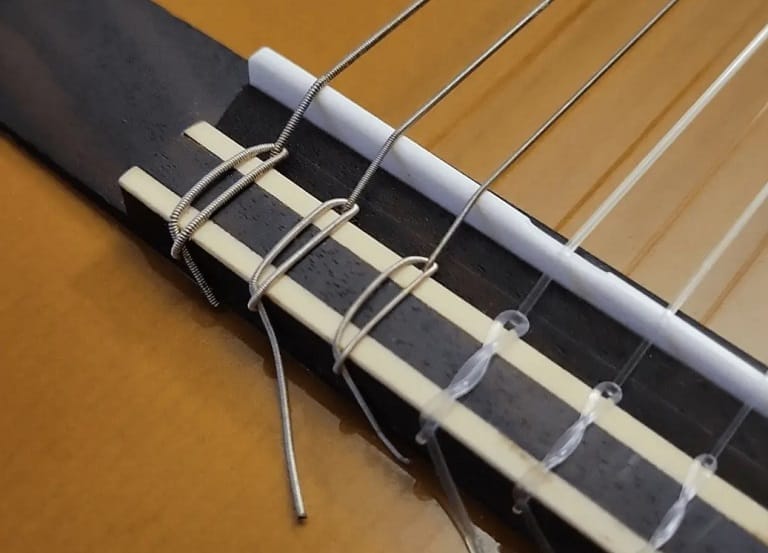
Gut Strings
On the other hand, Gut strings possess a unique charm and historical significance. Traditionally crafted from sheep or cow intestines, gut strings deliver a rich, organic sound cherished by many purists and enthusiasts. Gut strings produce a unique timbre that is warm, resonant, and rich in overtones.
This natural material imbues the music with a deep and expressive quality, making gut strings a favored option for historical performances and enthusiasts seeking an authentic sound reminiscent of the classical era. They require careful maintenance and are sensitive to changes in humidity.
Multifilament core
Multifilament core strings represent a modern development in classical guitar string technology. These strings combine various materials to create a high-quality, versatile player option. A multifilament core usually has a mix of synthetic fibers, making it more stable, long-lasting, and flexible in tone.
Exploring Medium and High Tension Strings
Tension in classical guitar strings refers to the force exerted on the guitar’s neck and body when the strings are tuned to pitch. It directly influences playability, sound projection, and tonal characteristics.
Higher tension strings have more significant force, requiring more finger strength to press down on the frets, producing a louder and more resonant sound. On the other hand, lower-tension strings are more comfortable to play, but they may create a softer and less powerful sound.
Medium-Tension
Medium tension strings strike a balance between playability and sound projection. They offer a more comfortable playing experience, reducing hand fatigue during extended practice or performance sessions. The moderate tension allows for easier fretting, making them popular for players of all levels, especially those who prefer a softer touch.
However, some players might find that medium-tension strings lack the volume and projection of higher-tension strings. Additionally, they might not suit those seeking an exceptionally bright and powerful sound.
High-Tension
High-tension strings provide a robust and full-bodied sound with excellent projection. They are favored by players seeking a powerful and assertive tone, making them suitable for solo performances and larger venues. The increased tension can also help maintain better intonation and sustain.
However, high-tension strings require more finger strength to press down on the frets, which might be challenging for beginners or players with hand-related issues. The higher tension can also stress the guitar’s neck more, potentially causing structural problems over time.
Why Is It Important To Choose The Right Sting?
Picking the right guitar string is very important because it connects your fingers to the instrument and affects its sound. It also decides how comfortable playing and how expressive the music is.
Strings of different lengths and materials produce different tones. The right strings can improve your guitar’s sound, whether it’s bright and punchy or warm and soft.
Action is affected by the gauge and tension of the strings, which in turn affects how easy it is to play. Lighter strings are easier to press and bend. Heavy strings, however, may give you more volume and stamina.
Also, you may need different strings for each style of music. For instance, jazz musicians like flat-wound strings because they feel smooth and mellow, while rock guitarists might choose round-wound strings because they sound clear and bright.
Basically, the right guitar string improves your skill and sound and brings you closer to your music.
Top Brands for The Best Classical Guitar Strings
Below, I have listed some of the best classical guitar strings on the market.
D’Addario XTC45FF Classical Dynacore Carbon
The D’Addario XT Classical Dynacore Carbon strings exemplify how tradition and innovation can work together. They were made for the thoughtful classical guitarist who wants to push the limits of sound and performance. These strings have a spirit of innovation that embraces technology while still paying homage to the classical soul.
Dynacore technology uses a multifilament core to give these strings a strong and resonant sound—like the strong but flexible backbone of an experienced player. This core is wrapped in high-density carbon fibers, which make the strings last longer and keep their tone, which classical players love.
These strings also have an XT finish from D’Addario to ensure they last. This process protects the strings from the things that usually break them, so they stay longer without losing the feel or tone that classical guitarists appreciate.
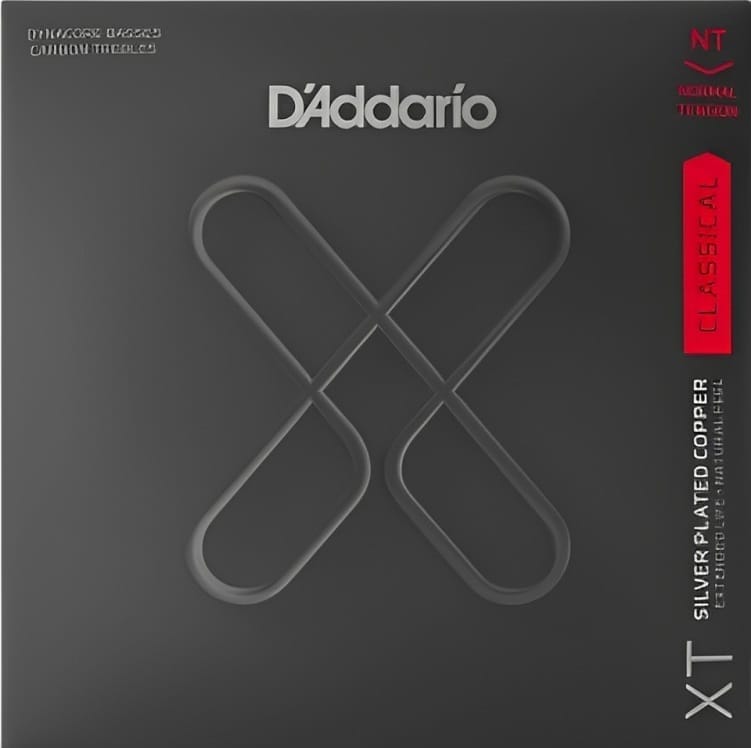
Pros
Quality: The new Dynacore technology gives the sound a strong and resonant base, so every note has the full emotional weight it was meant to have.
Tonality: The XT coating on these strings makes them last longer, so players can enjoy their full tones for longer without changing them as often.
Technology with Tradition: The carbon trebles give the sound a sparkling clarity that can make even the most complicated parts stand out. This is a treat for both the player and the audience.
Cons
Costly: They are more expensive than traditional classical guitar strings.
Savarez S.A. 500AJ Alliance Corum
The Savarez S.A. 500AJ Alliance Corum strings are like a finely tailored suit for the classical guitar cut from a cloth of innovation and tradition. With a careful nod, these strings are wound precisely to bring out the rich beauty of classical and flamenco music.
The Alliance trebles are made of a hybrid monofilament known for being strong and having a wide range of tones. These high-tensile fibers sing with brilliance and clarity, taking the guitarist’s melody to new heights and letting them explore sounds beyond the everyday.
The silver-plated and carefully wound Corum basses offer the perfect mix of warmth and projection. They are very flexible and can react to very light touches. Their dynamic range can carry both the whisper of a breeze and the roar of the sea.

Pros
Versatile and Expressive: The Alliance fiber trebles provide a crisp, clear sound that cuts through precisely, perfect for complex and fast fingerwork.
Bright Tone: Savarez’s Corum basses deliver a full-bodied sound with an exceptional balance of warmth and brightness, accommodating both vigorous strumming and delicate picking.
Smooth playability: These strings are responsive, so the musician can play with even the smallest changes in tone, from the softest pianissimo to the strongest fortissimo.
Cons
Challenging to play for beginners: People who are used to the deep warmth of traditional nylon strings might find the Alliance fibers’ clearness and brightness challenging. They might need some time to get used to their unique sound.
La Bella 820 Elite
The La Bella 820 Elite string set is the choice of experts for passionate flamenco guitarists. It was made to fit the fast-paced and emotional style of play that is typical of the style. With a light touch on the strings, these strings produce a wide range of bright tones. This lets the guitar sing with a lively energy.
La Bella 820 strings not only do they sound good, but they also beat with the heart of flamenco.
The silver-plated wound bass strings perfectly balance the warm strings, which makes every note clear and precise. Their bright sound makes every bass note stand out, like a heartbeat that keeps the dance’s flow going.
The 820 Elite set is excellent for guitarists. The smoothness of the strings under the fingers makes moving along the fretboard easy, allowing the player to do complicated fingerstyles with no trouble. Along with this tactile pleasure, there is a balance of tones that ensures every show is full of sound and words.
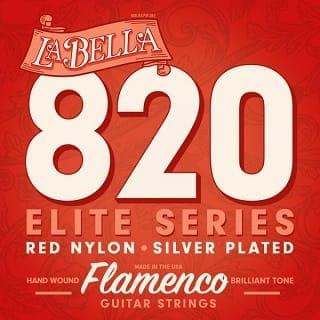
Pros
Flamco Specialist: Light finger pressure on the strings makes them perfect for flamenco methods with lots of nuances, giving you a wide range of expression.
Warm sound: The mix of red nylon trebles and silver-plated basses creates a warm and clear sound that meets the needs of classical guitarists who want a wide range of tones.
Playability: A big plus is how easy it is to play. It makes playing more comfy and expressive, which leads to more extended practice and performance sessions.
Cons
Not so versatile: They are great at playing traditional and classical music, but musicians who like to switch between styles may be unable to use them because they are so specialized.
Ernie Ball Nylon Ball End Strings
The Ernie Ball Nylon Ball End strings are a great mix of functionality and beauty. They were made for guitarists who like to change strings quickly without sacrificing sound quality. These strings are a mix of old and new. They have the simplicity of modern design and make the classic tones that have been a part of classical guitar music for hundreds of years.
Because the high strings are nylon, each note has a warm, lush sound. The sound envelopes the listener in a soft but rich sound. A traditional ear will enjoy this sound, but it’s also polished enough to appeal to a modern artist who wants their music to have depth and presence.
Along with the nylon trebles, the bass strings are wrapped in a silver-plated copper wire. This improves the overall sound quality by adding a clear, powerful bass. The sound is full, meaning songs will have a strong base on which to build.

Pros
Simplify string-changing process: The shape of the ball end makes changing strings easier, so it’s easy for players of all skill levels to set up quickly and efficiently.
Bright, clear tone: When you combine the warm tone of the nylon trebles with the balanced sound of the silver-plated bass strings, you get a standard sound that works well for many styles, from flamenco to fingerstyle.
Long sustain: Because Ernie Ball is known for making high-quality strings, you can be sure that these will last a long time and keep their tone and performance.
Cons
Can be difficult to play: Even though the ball ends make things easier, experts might notice that this modern touch slightly changes the string angle and tension, which could change how the classical guitar feels and how easy it is to play.
Have you checked out classical guitar tuning and alternative tunings?
D’Addario EJ27N
The D’Addario EJ27N classical guitar strings are a great example of how quality and ease of use can make music fun for players of all skill levels. These strings feel like a warm hug for new players, and experienced players enjoy their reliability.
The EJ27N strings are made with clear nylon trebles, which produce warm and clear sounds. The silver-plated copper wound on a nylon core for the bass strings adds to this warmth. Together, they make a balanced and round tone that boosts the melodic lines.
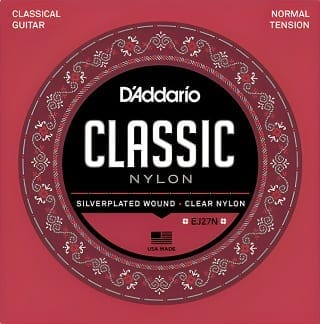
Pros
Affordability: For beginners and people looking for a good option on a budget, the EJ27N strings are a great choice because they are both budget-friendly and work well.
Versatility: Their clear nylon trebles and perfectly wound bass strings give them a sweet and strong sound, making them great for many different types of classical music.
Long-lasting: Because D’Addario is known for strict quality control, each string is made to be consistent and last a long time. This ensures that the tuning stays stable and the strings can be played for a long time.
Cons
Tonal Limitation: Even though these strings are very cheap and easy to play, more experienced players may want to find more specialized strings that offer a wider range of tonal colors and more powerful expressions for professional performances.
D’Addario XTC45
Another fine product from the XT Classical line is the D’Addario XTC45. For classical guitarists who need strings that can handle the wear and tear of daily practice and performance, the XTC45 set combines the company’s well-known craftsmanship with new ways of covering strings.
The unique Composite core silver-plated copper in these strings gives them a rich yet clear sound that ensures every note is played accurately and deeply. This guitar’s composite core is made to keep its intense sound and tune even when the weather changes and you play for a long time.
D’Addario’s XT finish adds another layer of protection against corrosive elements. This makes the strings last longer without changing how they feel or sound inside your fingers. Because of this, the XTC45 set is a strong option for musicians who play a lot and want quality that lasts.

Pros
Durability: The XT coating makes the guitar last longer and keeps the natural tone and feel, so you don’t have to change the strings as often, and the performance is always the same.
Tonal Quality: The composite core gives the guitar a deep, rich sound with better projection, allowing you to play with power or in a more gentle way.
Stability: These strings are very stable when tuning; they don’t change sound when the temperature or humidity changes.
Cons
Cost: Because the XTC45 strings use more modern technology and materials, they may cost more than regular strings. This could be a problem for students or people trying to save money.
ERNIE ERNESTO PALLA BLACK GOLD B/E
If you’re a musician who likes strings that look good and sound great, the Ernie Ball Ernesto Palla Black and Gold ball-end classical guitar strings are a sign of quality. These strings show that the brand is committed to giving artists choices that sound great and make their instruments look classy.
Click here to find the best classical guitar artist of all time.
When you think of Ernie Ball, you probably think of cutting-edge string technology. The Ernesto Palla line is no different. The black nylon trebles in the Black and Gold set make a warm and smooth sound that can make tunes sing with a velvety touch. Additionally, these come with gold-toned wound bass strings that make your guitar look royal and give it a full-bodied sound with lots of projection.
These strings’ ball-end shape is a nod to ease; it makes them easy to put on classical guitars. This feature of the design makes changing strings quick and easy, which is excellent for players who are always on the go or who’d rather play than fiddle with their instrument’s gear.

Pros
Elegant Design: The strings’ unique black and gold color scheme makes your instrument look classy.
How Easy It Is to Use: The ball-end design makes changing strings easier, which is excellent for people who value ease of use.
Warm Sound: The black nylon trebles have a warm, soft sound, and when combined with the gold basses, they create a well-balanced and pleasing soundscape.
Cons
Niche Appeal: The Black and Gold strings’ unique color and sound might appeal to a smaller group of people. Classical guitarists who like the look and sound of clear nylon strings might not like them.
Hannabach 725 Goldin
Nothing is more luxurious than the sound and look of the Hannabach 725 Goldin set of classical guitar strings. These strings are made for classical guitar experts and live up to Hannabach’s long history of making high-quality string sets that meet picky artists’ needs in terms of sound and style.
The first new thing about the 725 Goldin line is “Goldin,” a golden-yellow synthetic fiber used for treble strings. People know these fibers can produce a bright, clear sound that can bring out the subtleties of classical guitar music.
These strings are perfect for guitarists who need to control dynamics precisely. They let you play from pianissimo to fortissimo without losing clarity or flavor. The premium materials used to make the Hannabach 725 Goldin strings give them substantial longevity and consistent sound quality over a long period.

Pros
Superior Material Quality: The bass strings are gold wire, and the upper strings are gold fiber. This combination produces a great sound and is long-lasting.
Brilliant Sound: The synthetic Goldin trebles produce a bright, clear tone, and the gold wire basses give the lower ranges a rich, resonant sound.
Appealing look: Guitar players who care about the sound and appearance of their instruments will enjoy these strings.
Cons
Price: The Hannabach 725 Goldin is a premium string set that costs more. This means that beginners or people who don’t have a lot of money to spend on guitar equipment might be unable to afford it.
Gut String Brands
Some of the best classical guitar strings are gut strings. Here are 5 esteemed gut string brands:
Aquila
Aquila is a reputable brand that offers a wide range of gut strings for classical guitars. It is known for its dedication to traditional string-making techniques, providing musicians with authentic gut string options.

Pirastro
Pirastro is a renowned string manufacturer that produces gut strings alongside its other string offerings. They have a strong reputation for crafting gut strings that cater to the discerning needs of classical guitarists.

Gamut
Gamut Music is a respected brand in the realm of gut strings. They produce gut strings for various instruments, including classical guitars, adhering to historical techniques and materials.

Kürschner
Kürschner is a specialized brand that produces gut strings for classical and early music instruments. Its expertise ensures high craftsmanship and tonal quality.

Damian Dlugolecki
Damian Dlugolecki is an esteemed luthier and string maker well-known for crafting gut strings by hand. His artisanal approach and attention to detail result in gut strings cherished by classical guitarists seeking an authentic historical sound.

Check out some Classical guitar accessories here.
Additional Tips and Maintenance
I removed the old string and loosened the tension to string my classical guitar correctly. Then, I insert the ball end of the new string into the bridge hole, securing it with a knot. Next, I carefully wind the string around the tuning peg, ensuring even tension and leaving enough slack for stretching.
Once the string is secure, I tune it to the desired pitch and repeat the process for the remaining strings.
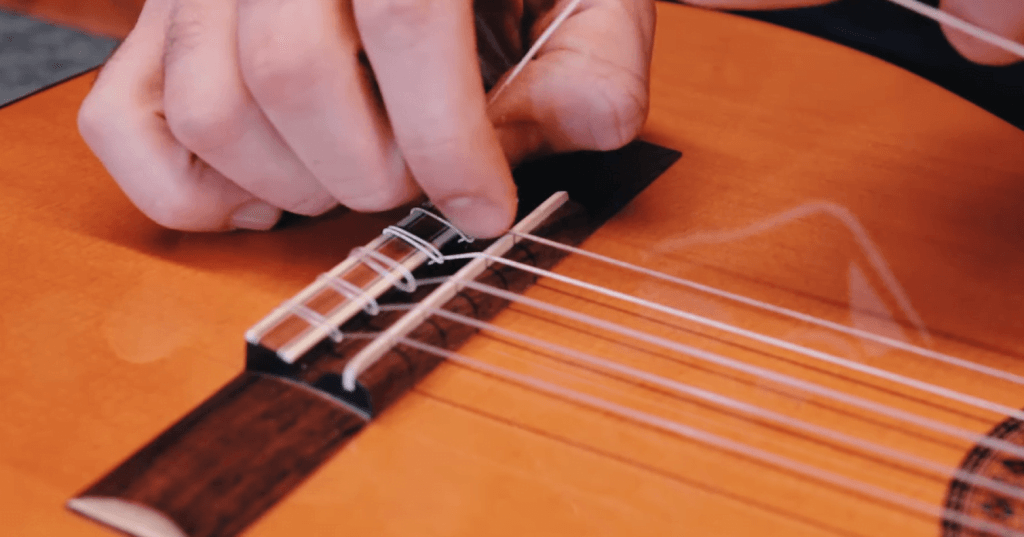
To extend the life of my strings, I wipe them down with a clean cloth after each playing session to remove dirt and oils. I also wash my hands before playing to minimize the corrosive effects. Regularly inspecting the strings for signs of wear or fraying helps identify when replacements are needed.
Additionally, storing the guitar in a controlled environment, away from extreme temperatures or humidity, ensures the strings stay in optimal condition.
What Should You Think Before Buying Your Classical Guitar Strings?
When considering the purchase of classical guitar strings, there are several crucial factors to remember to ensure you choose the correct set for your needs. Here’s what you should think about before buying classical guitar strings:
String Material
Classical guitar strings are typically made from nylon, fluorocarbon, and sometimes composite materials. Each material offers a unique tone and feel. Nylon strings are traditional and provide a warm, mellow sound, while fluorocarbon strings tend to have a brighter, more articulate tone. Consider the sound you prefer when choosing the material.
Tension Level
Classical guitar strings come in various tension levels, such as low, standard, and high. The tension affects playability and tone. Low-tension strings are easier on the fingers and produce a softer sound, while high-tension strings offer more projection and sustain. Your playing style and comfort should guide your choice.
Gauge
Gauge refers to the thickness of the strings. Classical strings often come in light, medium, and heavy gauges. Lighter gauges are generally easier to play but may sacrifice some volume and tone. Heavier gauges can produce a louder, richer sound but may require more finger strength. Your playing preferences should dictate your choice of gauge.
Wound or Unwound
Some classical guitar strings feature wound bass strings (usually the lower three strings), while others are entirely unwound. Wound strings add depth and resonance to the bass notes but might require more maintenance. Unwound strings offer a bright and clear tone on the treble strings. Consider whether you prefer wound or unwound bass strings.
Brand and Model
Various reputable string manufacturers offer classical guitar strings. Brands like D’Addario, Savarez, Augustine, and La Bella have earned the trust of the classical guitar community. Experimenting with different models from these brands can help you find your ideal sound.
Playing Style
Your playing style matters. If you’re into fingerstyle, you may prefer strings that allow intricate fingerpicking. If you play classical repertoire, strings with excellent sustain and projection are essential.
Budget
Consider your budget, as classical guitar strings come in a wide price range. While premium strings often offer superior tone and longevity, budget-friendly options can also provide decent performance.
Experimentation
Don’t hesitate to experiment with different string sets to find the perfect match for your guitar and playing style. It may take some trial and error to discover your preferred strings.
By carefully evaluating these factors and trying out a few different sets, you can make an informed decision when buying classical guitar strings that enhance your playing experience and bring out the best in your instrument.
Read more on the Best Budget Classical Guitars here.
Does String Material Affect Guitar Tone?
Yes, the string material significantly affects the guitar tone. Different string materials produce distinct tonal characteristics due to their physical properties and construction. Here’s how various string materials influence guitar tone:
Nylon Strings
Nylon strings are popular in classical and flamenco guitars. They produce a warm and mellow tone with a smooth and rounded sound. They are known for their ability to create expressive and nuanced dynamics. Nylon strings are gentle on the fingers, making them ideal for fingerstyle playing.
Steel Strings
Steel strings are standard on acoustic and electric guitars. They offer a brighter and more articulate tone compared to nylon. Steel strings provide increased projection, sustain, and a crisp attack. They are versatile and suitable for various musical styles, from folk and country to rock and blues.
Bronze-Wound Strings
Bronze-wound strings, such as 80/20 bronze or phosphor bronze, are commonly used on acoustic guitars. They offer a balanced tone with warmth and clarity. Phosphor bronze strings, in particular, tend to have a slightly warmer and mellow sound compared to 80/20 bronze.
Nickel-Wound Strings
Nickel-wound strings are often used on electric guitars. They produce a bright and clear tone with a smooth feel. Nickel strings are known for their versatility and ability to handle various playing styles, including bending and vibrato techniques.
Coated Strings
Coated strings, such as polymer coatings, have a layer of protection to extend their lifespan and maintain tonal quality. They tend to have a slightly warmer tone compared to uncoated strings.
Flatwound Strings
Flatwound strings are often used on jazz and vintage guitars. They have a smooth, mellow, warm tone with reduced finger noise. Flatwounds are favored for their vintage sound and smooth playability.
FAQs
The frequency of string changes depends on your playing habits and the condition of the strings. On average, it’s recommended to change classical guitar strings every 1 to 3 months or when you notice signs of wear, loss of tone, or difficulty in tuning.
No, classical guitars are designed for lower tension strings like nylon, gut, or composite strings. Using steel strings can cause excessive strain on the guitar’s neck and can damage the instrument. Always use strings specifically designed for classical guitars to ensure proper playability and tone.
Yes, classical guitars do require special strings. Unlike steel-string or electric guitars, classical guitars typically use nylon strings. These strings are specifically designed for classical guitars and are essential for achieving the traditional and characteristic classical guitar sound.
- Budget Classical Guitars Under $700 - February 15, 2025
- How To Set Up A 12-String Guitar Perfectly - September 8, 2023
- Vibrato Techniques: A Comprehensive Guide - September 6, 2023









